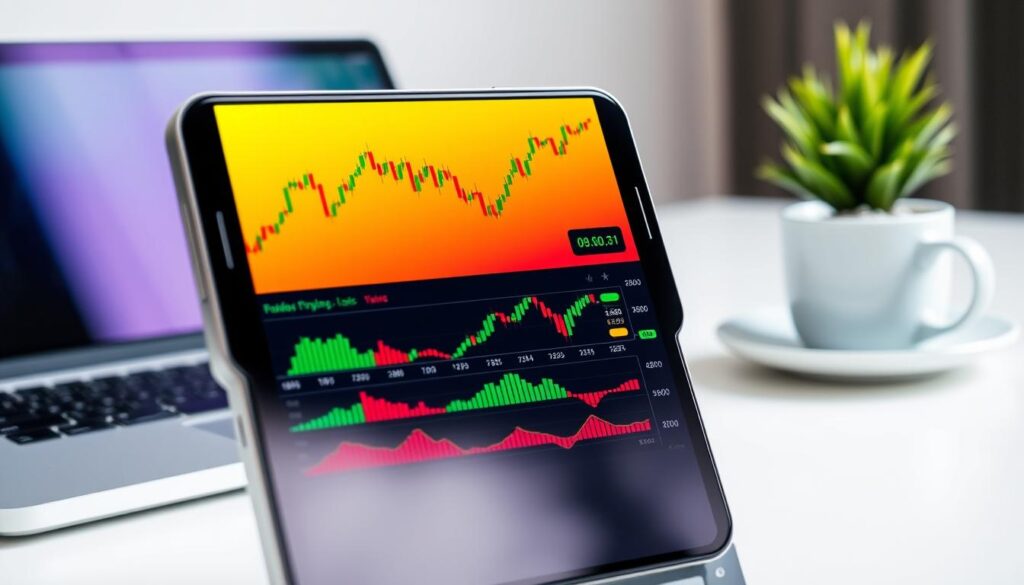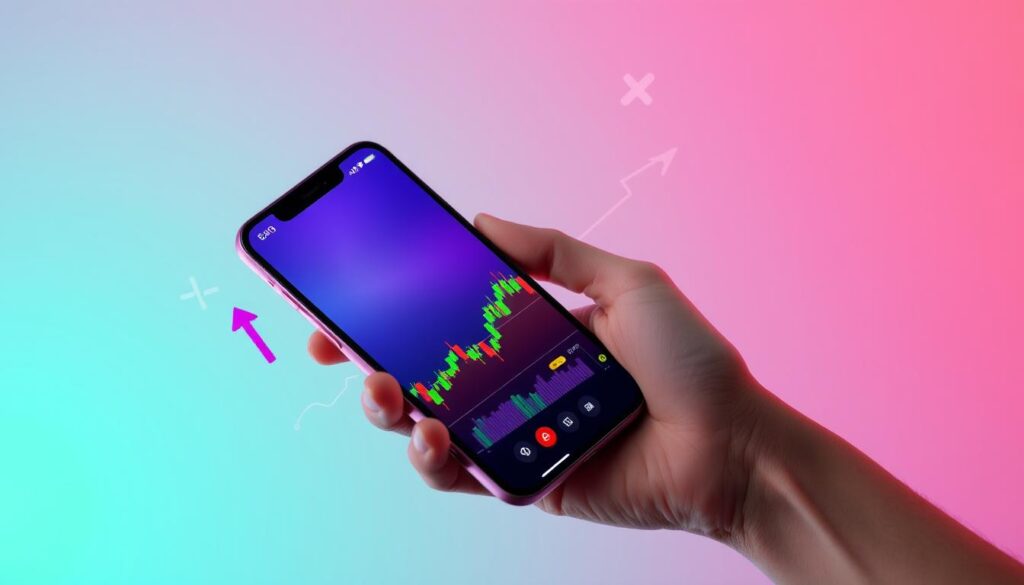Robinhood is a popular online broker that has revolutionized the industry by offering no trading commissions, making it an attractive option for beginners looking to start Robinhood trading. Founded in 2013 by Vlad Tenev and Baiju Bhatt, Robinhood has emerged as a user-friendly stock market app that allows users to invest in the stock market with ease. With its commission-free trades, Robinhood has made it possible for anyone to start trading, making it an ideal platform for those looking for a beginner’s guide to trading.
As a beginner’s guide, this article will walk you through each step of getting started on Robinhood, from creating an account to making your first trade. With its mobile trading app and direct cryptocurrency access, Robinhood has made it easy for users to invest in the stock market. Whether you’re looking to start Robinhood trading or simply want to learn more about the platform, this guide is for you.
With Robinhood, you can start trading with ease, and its fractional-share trading feature allows you to invest in stocks with as little as $1. As a stock market app, Robinhood provides a user-friendly interface that makes it easy to navigate and make trades. So, if you’re looking to start your trading journey, Robinhood is a great place to start, and this beginner’s guide will show you how to get started with Robinhood trading.
Table of Contents
Key Takeaways
- Robinhood is a commission-free trading platform that makes it easy to invest in the stock market.
- Robinhood offers a user-friendly mobile trading app that allows for direct cryptocurrency access.
- With Robinhood, you can start trading with as little as $1 using its fractional-share trading feature.
- Robinhood provides a beginner’s guide to trading, making it easy for new users to get started.
- Robinhood trading is a great way to start investing in the stock market, and this guide will show you how to get started.
Understanding What Robinhood Offers
Robinhood is a popular trading platform that offers a range of investment options, including stocks, ETFs, options, and cryptocurrencies. One of the key Robinhood features is commission-free trading, which allows users to buy and sell assets without incurring additional fees.
The platform is designed to be accessible through both mobile app and web browser, making it easy for users to trade on-the-go. With commission-free trading, users can keep more of their profits and minimize their losses. This is particularly beneficial for frequent traders who can save a significant amount of money on trading fees.
Some of the investment options available on Robinhood include:
- Stocks: Users can buy and sell stocks of various companies, including well-known brands and smaller startups.
- ETFs: Exchange-traded funds offer a diversified portfolio of assets, allowing users to spread their risk and potentially increase their returns.
- Options: Robinhood offers options contracts on various assets, including stocks and ETFs. Users can buy and sell options to speculate on price movements or hedge their positions.
- Cryptocurrencies: Users can buy and sell popular cryptocurrencies like Bitcoin and Ethereum, allowing them to participate in the growing digital asset market.
Overall, Robinhood’s commission-free trading and diverse range of investment options make it an attractive platform for both new and experienced traders. By understanding the various Robinhood features and investment options available, users can make informed decisions and achieve their financial goals.
| Investment Option | Description |
|---|---|
| Stocks | Buy and sell individual company stocks |
| ETFs | Diversified portfolio of assets |
| Options | Buy and sell options contracts on various assets |
| Cryptocurrencies | Buy and sell popular digital currencies |
Getting Started with Your Robinhood Account
To begin your trading journey, setting up a Robinhood account is the first step. The Robinhood account setup process is designed to be straightforward and user-friendly, making it easy for anyone to get started with trading. When you decide to open a Robinhood account, you’ll need to provide some personal and financial information to comply with US government laws and FINRA rules.
The Robinhood account registration process typically takes 5-7 days to review the materials and to be approved. You can even make a queued deposit while submitting your application, ensuring your funds are ready to invest once your account is approved. It’s essential to note that you must be 18 years or older to open a Robinhood account, and you’ll need a valid Social Security Number and a legal US residential address.
Here are some key points to keep in mind when setting up your Robinhood account:
- You must be 18 years or older to open an account
- A valid Social Security Number is required
- You’ll need a legal US residential address within the 50 states, Puerto Rico, or the US Virgin Islands
- The account registration process typically takes 5-7 days
- You can make a queued deposit while submitting your application
Once you’ve completed the Robinhood account setup process, you’ll be ready to start trading. Remember to always keep your account information up to date and ensure you have the latest version of the Robinhood app to prevent any losses caused by using outdated software. With a Robinhood account, you can start investing in the stock market and take control of your financial future.
By following these simple steps, you can easily set up your Robinhood account and start trading. The Robinhood account registration process is designed to be easy and efficient, allowing you to get started with trading as soon as possible.
| Account Type | Description |
|---|---|
| Individual Investing Account | For individual investors, typically takes 5-7 days to review and approve |
| Joint Investing Account | For two co-owners with equal ownership rights, typically takes 5-7 days to review and approve |
| Retirement Accounts | Traditional IRA and Roth IRA options available |
Required Documentation for Account Verification
To complete the Robinhood verification process, you’ll need to provide certain account documentation. This includes personal information such as your name, address, citizenship, and tax ID. Additionally, you’ll need to provide financial information, including bank account details, trading experience, and employment status.
The Robinhood verification process is designed to ensure the security and integrity of your account. By providing the required documentation, you’ll be able to link your bank account and start trading. The bank linking process is straightforward and secure, with multiple methods available for submitting documents, including using the mobile app to take photos or upload PDFs.
Identity Verification Process
The identity verification process typically involves submitting a government-issued ID, such as a driver’s license or passport. You may also need to provide a social security card or permanent residency card. The guide provides tips on submitting various types of documents, including troubleshooting common issues such as password-protected PDFs and large file sizes.
Financial Information Requirements
Financial information requirements include providing bank account details, such as your account number and routing number. You may also need to provide proof of income or employment status. The Robinhood verification process is designed to ensure that your account is secure and compliant with regulatory requirements.
Bank Account Linking Steps
To link your bank account, you’ll need to follow the steps outlined in the guide. This includes providing your bank account details and verifying your account ownership. The bank linking process is secure and straightforward, with multiple methods available for submitting documents and verifying your account information.
By following these steps and providing the required account documentation, you’ll be able to complete the Robinhood verification process and start trading. Remember to always prioritize account security and follow best practices for protecting your personal and financial information.
Navigating the Robinhood Interface
Robinhood’s app is designed with a simple and intuitive trading platform interface in mind, making it easy for users to navigate and find the tools they need. The Robinhood app navigation is straightforward, allowing users to quickly access their account information, trading options, and educational resources.
Some of the key features of the Robinhood interface include:
- Customizable dashboard for tracking portfolio performance
- Real-time market data and news updates
- Easy access to trading options, including stocks, ETFs, and options
- Interactive educational resources, such as quizzes and simulations
By understanding the Robinhood app navigation and trading platform interface, users can make the most of their trading experience and stay informed about market trends and conditions. With its user-friendly design and comprehensive features, the Robinhood interface is an essential tool for anyone looking to start trading or expand their investment portfolio.
Whether you’re a beginner or an experienced trader, the Robinhood interface is designed to provide a seamless and intuitive trading experience. By taking the time to explore the platform and its features, you can gain a deeper understanding of the trading platform interface and make more informed investment decisions.
Funding Your Trading Account
When it comes to Robinhood account funding, the process is straightforward and secure. Robinhood’s sign-up procedure includes asking for bank account information through Plaid or other secure connection tools, making funding simple and quick. You can choose from various deposit methods, including standard bank transfers, debit card transfers, and instant deposits.
To fund your account, you can use the following methods:
- Standard bank transfers: take up to 5 business days to be available
- Debit card transfers: typically take 30 minutes but may vary depending on the bank
- Instant bank transfer deposits: allow you to deposit money from your bank to your Robinhood account in minutes
It’s worth noting that instant deposits are a convenient option, but they may have certain limits and requirements. You can find more information on reliable trading platforms and their deposit options.
Recurring deposit options are also available, with frequencies including weekly, twice a month, monthly, and quarterly. However, only one recurring deposit per frequency can be set up from each bank account.
| Deposit Method | Transfer Time | Transfer Limit |
|---|---|---|
| Standard Bank Transfer | Up to 5 business days | Reset daily at 7 PM ET |
| Debit Card Transfer | Typically 30 minutes | Reset daily at 12 AM ET |
| Instant Bank Transfer | Minutes | Reset daily at 12 AM ET |
By understanding the different deposit methods and their requirements, you can choose the one that best suits your needs and start trading with Robinhood account funding that works for you.
Understanding Market Orders and Trade Types
When trading on Robinhood, it’s essential to understand the different Robinhood order types available. The platform offers market orders and limit orders, each with its own characteristics and uses. During regular market hours, dollar-based buy orders are entered as market orders, while share-based buy orders are entered as limit orders with a preset limit price.
A key aspect of market orders is that they are executed immediately at the best available price. This can be beneficial for traders who want to quickly enter or exit a position. On the other hand, limit orders allow traders to specify a maximum price they are willing to pay or a minimum price they are willing to sell for. This can help traders avoid overpaying for a security or selling it too cheaply.
It’s also important to note that Robinhood order types can be affected by market conditions. For example, during extended-trading hours, share-based and dollar-based buy orders default to limit orders. Additionally, market orders placed outside regular market hours may have their buying power over-reserved by 5% to prevent overspending.
To make informed trading decisions, it’s crucial to understand the different Robinhood order types and how they work. By familiarizing yourself with market orders and limit orders, you can better navigate the trading process and achieve your investment goals.
Trading on Robinhood: Platform Features and Tools
Robinhood offers a range of trading tools and features to help users make informed investment decisions. With stock screening tools, users can quickly identify potential investment opportunities based on their individual criteria. Additionally, technical analysis tools provide users with real-time market data and basic charting capabilities to analyze trends and patterns.
Some of the key features of the Robinhood platform include:
- Commission-free trading for stocks, options, ETFs, and cryptocurrencies
- Real-time market data and basic charting tools for technical analysis
- Stock screening tools to identify potential investment opportunities
- Access to a range of investment products, including options and cryptocurrencies
By utilizing these Robinhood trading tools, users can enhance their trading experience and make more informed investment decisions. Whether you’re a seasoned trader or just starting out, the Robinhood platform provides a range of features and tools to help you achieve your investment goals.
| Feature | Description |
|---|---|
| Stock Screening | Identify potential investment opportunities based on individual criteria |
| Technical Analysis | Analyze trends and patterns with real-time market data and basic charting tools |
| Real-time Market Data | Stay up-to-date with current market trends and prices |
Managing Your Investment Portfolio
Effective Robinhood portfolio management involves regularly monitoring your investments and making adjustments as needed. This can include investment tracking to ensure your portfolio remains aligned with your financial goals.
To manage your portfolio, you can start by setting clear investment goals and risk tolerance. This will help you determine the right asset allocation for your portfolio. You can then use Robinhood portfolio management tools to track your investments and make adjustments as needed.
Some key considerations for investment tracking include:
- Asset allocation: This involves deciding how to divide your portfolio among different asset classes, such as stocks, bonds, and real estate.
- Diversification: This involves spreading your investments across different asset classes to manage risk and optimize returns.
- Rebalancing: This involves adjusting your portfolio periodically to ensure it remains aligned with your investment goals and risk tolerance.
By following these steps and using Robinhood portfolio management tools, you can effectively manage your investment portfolio and achieve your financial goals.
Risk Management Strategies for New Traders
As a new trader, managing risk is crucial to success in the trading world. Trading risk management involves a combination of strategies to minimize potential losses. One key aspect is setting a stop loss, which helps limit losses if a trade does not go as planned. Diversification is also essential, as it spreads risk across different assets, reducing the impact of any one investment’s performance.
Effective trading risk management requires a thorough understanding of the markets and the ability to analyze potential risks. This includes considering factors such as liquidity, volatility, and market trends. By developing a solid risk management plan, traders can better navigate the markets and make more informed decisions. Position sizing is another critical component, as it determines the amount of capital to allocate to each trade, helping to preserve capital and minimize losses.
To implement a successful risk management strategy, consider the following key points:
- Set clear goals and risk tolerance levels
- Develop a position sizing plan to manage capital allocation
- Use stop losses to limit potential losses
- Diversify investments to spread risk
By incorporating these elements into a trading plan, new traders can better manage risk and improve their chances of success in the markets. Remember, trading risk management is an ongoing process that requires continuous monitoring and adjustment to changing market conditions.
Understanding Robinhood Gold Benefits
Robinhood Gold is a premium offering that provides users with enhanced features and benefits, including margin trading, which allows for greater flexibility in trading strategies. With a monthly fee of $5, users can access bigger instant deposits, up to $50,000, and enjoy extended trading hours. The service also offers a 30-day free trial, allowing users to assess its benefits before committing to the subscription cost.
Some of the key benefits of Robinhood Gold include:
- Higher interest rate on cash sweep balances, at 5.25% APY
- Level II market data from Nasdaq, providing more detailed market insights
- Access to Morningstar research, with in-depth reports on approximately 1,700 stocks
- Margin investing with an 8% interest rate, and the first $1,000 in margin being interest-free
These premium features can be particularly beneficial for heavy traders, who can save up to $150 annually on futures contract fees and $180 annually on index options contract fees. Additionally, the Robinhood Gold Card offers 3% cash back on all purchases and 5% cash back on travel booked through the portal.
Overall, Robinhood Gold provides users with a range of benefits and features that can enhance their trading experience, including margin trading and higher instant deposit limits. By understanding the benefits and costs of Robinhood Gold, users can make an informed decision about whether this premium service is right for them.
Common Trading Mistakes to Avoid
As a trader on Robinhood, it’s essential to be aware of common trading mistakes that can lead to significant losses. Emotional trading is one of the most significant pitfalls, as it can cause traders to make impulsive decisions based on fear or greed. This can result in risk management errors, such as over-leveraging or failing to set stop-losses.
Some common trading mistakes include:
- Failure to set clear goals and strategies
- Insufficient research and analysis
- Over-trading or under-trading
- Failure to manage risk effectively
It’s crucial to develop a solid understanding of risk management principles and strategies to avoid these mistakes. This includes setting realistic goals, diversifying your portfolio, and using stop-losses to limit potential losses. By being aware of these common trading mistakes and taking steps to avoid them, you can improve your chances of success in the markets.
Remember, emotional trading can be a significant obstacle to success. By staying disciplined, patient, and informed, you can make more informed decisions and avoid common risk management errors. Always keep in mind that trading mistakes are an inevitable part of the learning process, but by being aware of them, you can minimize their impact and achieve your trading goals.
Mobile Trading Best Practices
When it comes to mobile trading, having the right strategies in place can make all the difference. With the Robinhood app trading platform, users can access a range of tools and features to help them stay on top of their investments. To get the most out of mobile trading, it’s essential to follow some key tips and best practices. One of the most important mobile trading tips is to stay informed and up-to-date with market news and trends.
This can be achieved by setting up notifications on the Robinhood app, which will alert users to any significant changes or developments in the market. Additionally, using widgets effectively can help users to quickly and easily access key information and data. By following these mobile trading tips, users can ensure that they are always in control of their investments, even when they are on the go.
Some other key mobile trading tips include maintaining security, using strong passwords, and enabling two-factor authentication. By taking these precautions, users can help to protect their accounts and prevent unauthorized access. With the Robinhood app trading platform, users can enjoy a secure and convenient mobile trading experience, with access to a range of tools and features to help them achieve their investment goals.
By following these best practices and mobile trading tips, users can get the most out of their mobile trading experience and stay ahead of the game. Whether you’re a seasoned investor or just starting out, the Robinhood app trading platform has everything you need to succeed in the world of mobile trading.
Tax Implications of Trading
As a trader on Robinhood, it’s essential to understand the tax implications of your trading activities. Trading taxes can be complex, but knowing the basics can help you navigate the process. One crucial aspect is the capital gains tax, which applies to profits made from selling investments.
The tax reporting requirements for Robinhood traders involve receiving a Consolidated 1099 form, which includes information on investment income and capital gains. It’s essential to report every transaction made on Robinhood to the IRS to avoid potential tax complications and penalties.
Here are some key points to keep in mind:
- Short-term capital gains are taxed as ordinary income, up to 37% federally.
- Long-term capital gains are taxed at starting rates of 15%, with high earners facing up to 23.8% federal tax.
- Holding investments for at least one year may lead to lower tax obligations.
It’s vital to educate yourself on the tax implications of trading to avoid potential pitfalls and make informed investment decisions. By understanding trading taxes, capital gains tax, and tax reporting requirements, you can navigate the world of trading with confidence.
| Tax Form | Due Date |
|---|---|
| Form 1099-R | January 31, 2025 |
| Consolidated 1099 | February 18, 2025 |
| Form 5498 | May 31, 2025 |
Security Measures and Account Protection
When it comes to trading safety, Robinhood takes the security of its users’ accounts very seriously. The company employs industry-standard security measures to safeguard accounts, including hashing account passwords using the BCrypt algorithm and encryption of sensitive information. Additionally, Robinhood uses the Transport Layer Security (TLS) protocol for secure communication with servers.
To further enhance account protection, Robinhood offers two-factor authentication (2FA), which requires users to verify their identity with a one-time verification code or device approval request in addition to their password. This extra layer of security helps prevent unauthorized access to accounts.
In the event of unauthorized activity, Robinhood offers reimbursement for direct losses. The company also provides Robinhood security measures such as SIPC protection, which covers securities up to $500,000, including $250,000 for cash claims. Furthermore, an additional insurance policy supplements SIPC protection, offering protection for securities and cash up to an aggregate of $1 billion.
- SIPC protection for securities up to $500,000
- Additional insurance policy for securities and cash up to $1 billion
- Two-factor authentication for enhanced account protection
- Encryption of sensitive information for secure communication
By prioritizing trading safety and account protection, Robinhood aims to provide its users with a secure and reliable trading experience. With its robust security measures in place, users can focus on their investments with confidence, knowing that their accounts are well-protected.
Conclusion
As you’ve learned, Robinhood offers a user-friendly platform that makes it easy for beginner investors to start trading on Robinhood. With its commission-free trades and intuitive mobile app, Robinhood has revolutionized the way people access the financial markets. Whether you’re interested in beginner investor tips or want to dive deeper into more advanced trading strategies, Robinhood provides the tools and resources to support your growth as an investor.
Remember, successful investing requires continuous learning, disciplined risk management, and a long-term mindset. Take the first step by opening your Robinhood account, and embark on an exciting journey of financial empowerment. With the knowledge you’ve gained from this guide, you’re well on your way to making informed trading decisions and achieving your investment goals.
FAQ
What is Robinhood and how does it work?
Robinhood is a popular financial services company that offers a user-friendly mobile app for trading stocks, options, cryptocurrency, and other investment products. It became known for its commission-free trading model, making it an attractive option for beginner investors.
What investment products are available on Robinhood?
Robinhood offers a variety of investment options, including stocks, options, exchange-traded funds (ETFs), and cryptocurrencies. The platform’s commission-free trading and accessibility across devices make it a popular choice for modern, on-the-go investors.
How do I set up a Robinhood account?
The process of setting up a Robinhood account is straightforward and user-friendly. You’ll need to provide personal information, such as your name, address, and social security number, as well as some financial details to verify your identity and link a bank account.
What documentation is required to verify a Robinhood account?
To verify your Robinhood account, you’ll need to provide information like a government-issued ID, social security number, and potentially recent bank statements or pay stubs. This step ensures the security of your personal information and the safety of your investments.
How do I navigate the Robinhood interface?
Robinhood’s interface is designed to be intuitive and user-friendly. The platform will guide you through the various features, such as monitoring your portfolio, placing trades, and accessing essential market data and research tools.
What are the different methods to fund my Robinhood account?
Robinhood offers several options to fund your trading account, including bank transfers, debit card deposits, and the Instant Deposit feature, which allows you to access your funds quickly. Each method has its own pros and cons, so you can choose the one that best fits your needs.
What are the different types of orders I can place on Robinhood?
Robinhood supports various order types, including market orders and limit orders. Market orders execute at the current market price, while limit orders allow you to set a specific price at which you’re willing to buy or sell. Understanding these order types is crucial for managing your trades effectively.
What research and analysis tools are available on Robinhood?
Robinhood provides a suite of tools to help you research and analyze stocks, including stock screening features, real-time market data, and interactive charts. These features can assist you in making informed investment decisions.
How do I manage my investment portfolio on Robinhood?
Robinhood offers various portfolio management tools, such as performance tracking, rebalancing capabilities, and the ability to set alerts. These features allow you to monitor your investments, make adjustments, and stay informed about your portfolio’s performance.
What risk management strategies should I consider on Robinhood?
Effective risk management is crucial for new traders. On Robinhood, you can employ strategies like setting stop losses, determining appropriate position sizes, and diversifying your portfolio to help mitigate potential losses and manage your overall trading risk.
What are the benefits of Robinhood Gold, the platform’s premium offering?
Robinhood Gold provides access to additional features, such as margin trading, enhanced instant deposits, and professional research reports. These premium features can be beneficial for more experienced traders, but it’s essential to understand the risks and implications before upgrading.
What are some common mistakes new traders should avoid on Robinhood?
New traders should be aware of potential pitfalls, such as emotional trading, insufficient risk management, and platform-specific mistakes. Understanding these common mistakes can help you develop a more disciplined and successful trading approach on Robinhood.
How can I optimize my trading experience on the Robinhood mobile app?
Robinhood’s mobile-first design offers several best practices for traders, including setting up notifications, utilizing widgets effectively, and maintaining robust security measures to protect your account and personal information.
What are the tax implications of trading on Robinhood?
Trading on Robinhood can have tax consequences, such as capital gains and losses. It’s important to understand the relevant tax reporting requirements, documentation needed, and how to properly account for your trading activity when filing your taxes.
How does Robinhood ensure the security of my account and personal information?
Robinhood has implemented various security measures to protect its users, including two-factor authentication, data encryption, and insurance coverage. These safeguards help ensure the safety of your investments and personal information on the platform.









